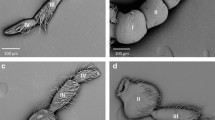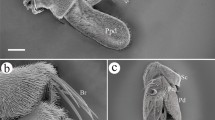Abstract
The fine structure and distribution of various types of antennal sensilla in three nymphal stages and in adults of both solitary-reared (solitary) and crowd-reared (gregarious) phases of the desert locust, Schistocerca gregaria, were investigated by scanning and transmission electron microscopy. Four types of sensilla were identified: sensilla basiconica, s. trichodea, s. coeloconica and s. chaetica. S. basiconica contain up to 50 sensory neurons, each of which displays massive dendritic branching. The sensillar wall is penetrated by a large number of pores. In contrast, s. trichodea contain one to three sensory neurons that branch to give five or six dendrites in the sensillar lumen; the sensillum wall is penetrated by relatively few pores. The s. coeloconica are situated in spherical cuticular pits on the antennal surface. The s. coeloconica are of two types: one type contains one to three sensory neurons with double sensillar walls penetrated by slit-like pores, whereas the second type contains four sensory neurons with non-porous double sensillar walls. The s. chaetica have a flexible socket and a thick non-porous sensillum wall and contain four sensory neurons that send unbranched dendrites to a terminal pore. A fifth sensory neuron of the s. chaetica terminates in a tubular body at the base of the hair. S. basiconica and coeloconica are normally distributed over the entire antennal flagellum, with a concentration in the middle segments; s. trichodea have three areas of concentration on the 5th, 10th and 14th flagellar segments. Sensilla chaetica are most abundant on the terminal segment. Locusts raised in solitary conditions have more olfactory sensilla (s. basiconica and s. coeloconica) than crowd-reared locusts. The difference in sensillar numbers is more evident in adults than in nymphs. These results suggest that differences in the odour-mediated behaviour of nymphs and adults, and between the phases of S. gregaria, may be attributable to differences at the sensory input level.
Similar content being viewed by others
Author information
Authors and Affiliations
Additional information
Received: 2 May 1997 / Accepted: 10 July 1997
Rights and permissions
About this article
Cite this article
Ochieng, S., Hallberg, E. & Hansson, B. Fine structure and distribution of antennal sensilla of the desert locust, Schistocerca gregaria (Orthoptera: Acrididae). Cell Tissue Res 291, 525–536 (1998). https://doi.org/10.1007/s004410051022
Issue Date:
DOI: https://doi.org/10.1007/s004410051022




